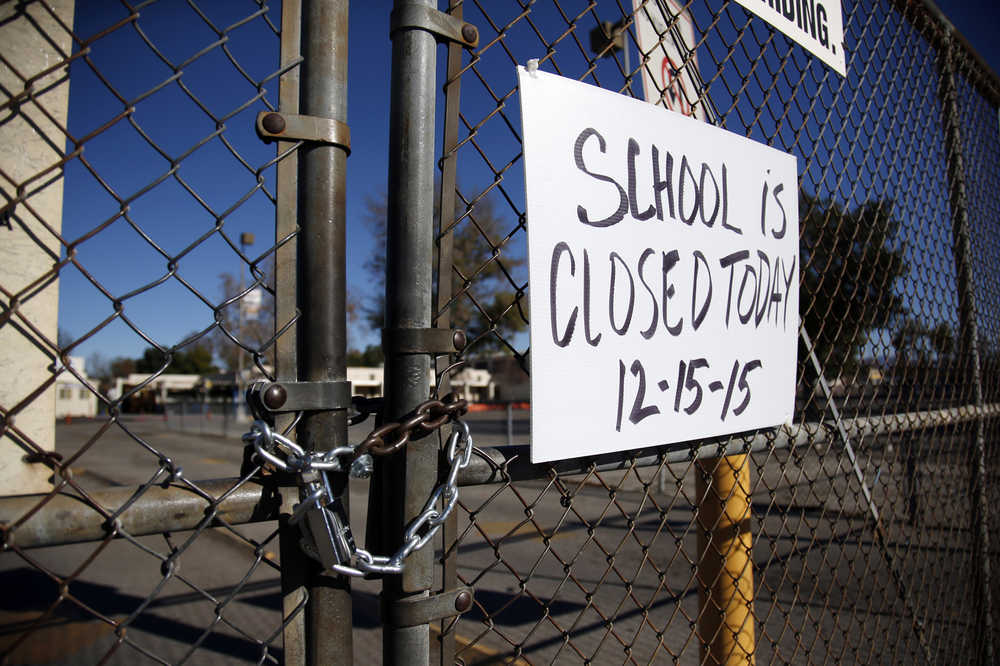LOS ANGELES — The nation’s two biggest school systems — New York City and Los Angeles — received threats Tuesday of a large-scale jihadi attack with guns and bombs, and LA reacted by shutting down the entire district, while New York dismissed the warning as an amateurish hoax and held class as usual.
The shutdown was a rare example of a major U.S. city closing its entire school district because of fears of an attack. The decision also reflected lingering unease in the aftermath of the shooting that killed 14 people at an office holiday party two weeks ago in nearby San Bernardino.
In LA, the threat came in the form of an email to a school board member. Authorities in New York reported receiving the same “generic” email and decided there was no danger to schoolchildren. Mayor Bill de Blasio concluded the threat contained “nothing credible.”
“It was so outlandish,” he said.
New York Police Commissioner William Bratton agreed, quipping that it looked like the sender of the threat had watched a lot of the Showtime terrorism drama “Homeland.”
The shutdown abruptly closed more than 900 public schools and 187 charter schools attended by 640,000 students across Los Angeles.
LA officials defended the move, with that city’s police chief dismissing the criticism as “irresponsible.”
“It is very easy in hindsight to criticize a decision based on results the decider could never have known,” Police Chief Charlie Beck said at a news conference.
Southern California, he added, “has been through a lot in the recent weeks. Should we risk putting our children through the same?”
The threatening 360-word email sent to the New York City school superintendent warned that schools would be attacked with pressure cooker bombs, nerve agents and machine guns. It claimed the writer and “138 comrades” would carry out the attack.
Students “at every school in the New York City school district will be massacred, mercilessly. And there is nothing you can do to stop it,” the message said.
A law enforcement official with access to the document provided the email to The Associated Press.
The official was not authorized to disclose details of an ongoing investigation and spoke on condition of anonymity.
The anonymous writer claimed to be a student at a district high school who had been bullied. The person also claimed to be a jihadist but made errors that suggested the writer was really a prankster, including spelling the word “Allah” with a lowercase “a.”
The threat made a pornographic reference to a body part that would be unlikely to come from a devout Muslim, and it contained no reference to the Quran.
The threats came in simultaneously to New York and LA school officials at about 1:20 a.m. EST Tuesday, or about 10:20 p.m. Monday in Los Angeles.
In LA, the school board member who received the threat immediately contacted school district police, Det. Rudy Perez said.
Across the country, a New York schools superintendent who received the threat was asleep and did not notice the email until 5:08 a.m. By 6:30 a.m., the message was sent to the NYPD.
An hour later, New York students began arriving at school, and by about 9:30 a.m. investigators ruled the threat a hoax.
The decision to close Los Angeles schools was announced around the same time, at 6:25 a.m. PST.
Los Angeles Superintendent Ramon Cortines said every campus would be searched before schools reopened.
Bratton called the closure in Los Angeles a “significant overreaction.”
“We cannot allow ourselves to raise levels of fear,” said Bratton, who once ran the LA Police Department.
White House spokesman Josh Earnest said he would not second-guess the decisions made in Los Angeles or New York.
The sudden, complete closure disrupted the routines of many Los Angeles families.
Lupita Vela, who has a daughter in the third grade and a son who is a high school senior, called the threat “absolutely terrifying” in light of the San Bernardino attack.
“I know the kids are anxious,” she said.
The LA schools commonly get threats, but Cortines called this one rare and said the San Bernardino attack influenced his decision to close the entire district.
The threat “was not to one school, two schools or three schools,” he said at a news conference. “It was many schools, not specifically identified. … That’s the reason I took the action that I did.”
The person who sent the threat used an “anonymizer,” which uses a proxy server to mask the origin of Internet traffic, and the email was routed through a German IP address, according to a law enforcement official briefed on the investigation. The official, who was not authorized to discuss an ongoing investigation, spoke on condition of anonymity.
Vela said she worries about talking to her kids about the threat and terrorism in general. She’s concerned about her daughter feeling secure in class.
“I don’t want this to be in the back of her head,” she said. “Who knows what it does psychologically to kids? Is this going to cause her some kind of trauma so that she’s not going to feel safe at school?”
The closure came the same day classes were canceled at San Bernardino Valley College because of a bomb threat.
___
Associated Press writers Tami Abdollah in Washington and Christopher Weber, Amanda Lee Myers, Michael Blood and Edwin Tamara in Los Angeles contributed to this report.

